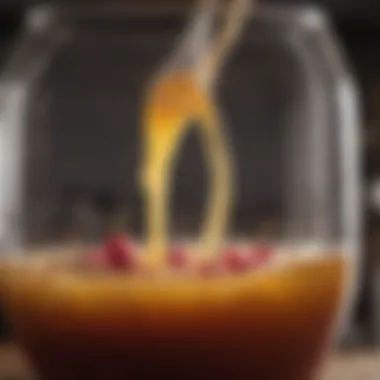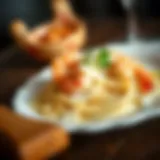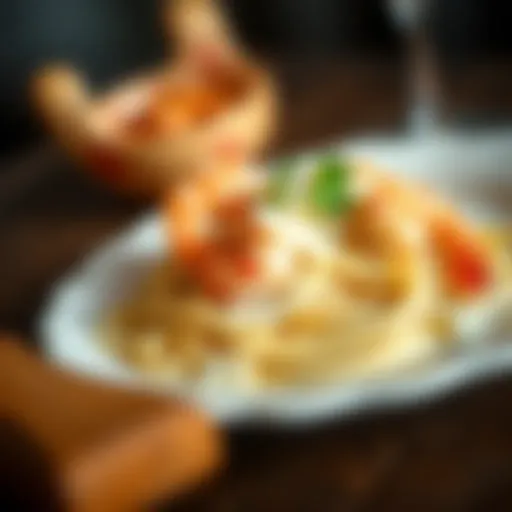Exploring Fruit Juice in Wine Making Techniques


Intro
The realm of winemaking presents a fascinating fusion of art and science, one where ingredients play a critical role in crafting unique beverages. Among these components, fruit juice emerges as a transformative agent, capable of elevating the wine's body and the overall tasting experience.
This guide serves as an exploration into the mechanics of employing fruit juice in winemaking. Emphasizing thoughtful selections of primary and optional ingredients, understanding techniques of preparation, and recognizing the importance of dietary considerations, this article offers valuable insights for enthusiasts at any level. The journey into the world of fruit-infused wine beckons where aromatic complexity meets methodical craftsmanship.
Ingredients Breakdown
Before embarking on your winemaking journey, it is essential to understand the ingredients that will define your final product. The choice of fruits and complementary components can significantly sway flavor profiles and affect fermentation outcomes.
Primary Ingredients
The primary ingredient, of course, is the fruit juice that will form the backbone of the wine. Popular options include:
- Grapes: Traditional and versatile, they provide various flavor profiles.
- Apples: Create a crisp taste with mild sweetness.
- Pineapple: Introduces tropical notes and acidity.
- Berries (such as raspberries or blueberries): Develop complexity and vibrant colors.
Optional Ingredients
While primary ingredients provide the fundamental aspect of the drink, optional components can enhance dimensions. Consider incorporating:
- Herbs: For additional aromatic qualities when used lightly.
- Spices: Such as cinnamon or cloves to add warmth.
- Zests: Citrus zests can brighten the profile.
Essential Kitchen Tools
A focused winemaking process necessitates the right tools. Recommendations include:
- Juicer: Efficiently extract liquid from fruit.
- Fermentation Vessel: Airlock containers are recommended to prevent oxidation.
- Thermometer: Maintain accurate temperatures during fermentation.
- Bottle and Corker: For final storage and sealing of wine.
Understanding these essential elements sets the foundation for creating a distinct wine tailored specifically to the maker's taste. Proper sourcing of quality juices ensures that the first step in winemaking will lead you easily into the following stages.
As we progress further in this guide, the focus will shift towards step-by-step preparation, demonstrating practical techniques and well-informed suggestions for the home winemaker.
Prelims to Wine Making with Fruit Juice
Making wine from fruit juice is an intriguing process that combines art and science. Many enthusiasts have turned to this method for several reasons, such as the affordability of fruit juices, the accessibility of ingredients, and the creative opportunity they present. Unlike traditional grape winemaking, which requires specific kinds of grapes and careful methods, juice from a variety of fruits provides a canvas for experimentation. This introduction lays the groundwork to enhance understanding of how to approach winemaking with fruit juice.
The significance of utilizing fruit juice in winemaking cannot be understated. For many aspiring winemakers, it provides an entry point into the craft. With different fruits varying widely in taste, aroma, and acidity, selecting the right juice can completely reshape the character of the final product. The wide palette allows artisans to craft flavors that traditional grape wines may not offer. For example, a peach wine can exude sweetness and lightness compared to a robust red wine crafted from black currants.
Additionally, the fermentation process, when using fruit juice, opens avenues for crafting distinctive flavors that represent personal preferences or regional characteristics. Each type of fruit carries its own unique sugars and acids—essential elements during fermentation. Every small choice in ingredients can result in a vastly different wine experience.
Moreover, incorporating fruit juice into winemaking campaigns a range of considerations—such as the balance of sugars and acidity—which directly impact the fermentation process. The fermentation process influences not only the flavor but also the texture and aroma of the resulting wine. Understanding these elements is crucial for successful outcomes.
By exploring how to select, process, and ferment fruit juices, this guide aims to enhance your knowledge. For home winemakers and enthusiasts alike, the journey of creating personalized wines is both rewarding and educational. It enables connection with the essence of each fruit's characteristic, transforming juice into fermented elixirs. The subsequent sections will provide detailed insights into each aspect of this vibrant world of fruit juice winemaking.
Understanding the Ingredients
Understanding the ingredients used in fruit juice wine making is crucial for any aspiring winemaker. The specific characteristics of fruit juices can significantly impact the overall flavor, aroma, and quality of the wine produced. By understanding how to choose and handle ingredients effectively, winemakers can create distinctive and enjoyable products.
Types of Fruit Juice Suitable for Wine
There are a myriad of fruit juices that can be utilized in the wine-making process. Some popular choices include:
- Grape Juice: Classic choice for winemakers, offering various styles from sweet to dry.
- Apple Juice: Provides a refreshing crispness; ideal for creating cider-like wines.
- Pear Juice: Elegant and subtly sweet, pairs well with spices in blends.
- Berry Juices: Such as raspberry and strawberry, give vivid color and unique aromatic profiles.
- Citrus Juices: Like orange or lemon, added in small quantities to enhance acidity.
Each of these juices brings different sugars, acids, and volatile compounds. Knowledge about these subtleties can guide choices about the types of wines to craft.
Characteristics of Quality Fruit Juices
Quality of fruit juices is paramount in wine making, Several attributes define what makes a juice suitable:
- Freshness: Juices should be made from the freshest fruits possible. Older juices may lose flavor and aroma quality.
- Purity: Look for juices without added sugars or preservatives. This helps in better fermentation processes.
- Color: Bright, vibrant colors often indicate a higher level of concentrated flavors.
- Sourness: Balancing acidity is necessary for creating a pleasant taste. Too acidic or too sweet can yield undesirable wines.
Paying attention to these details ensures that the final product captures the true essence of the chosen fruits.
Impact of Fruit Variety on Flavor and Structure


The variety of fruit used plays a significant role in determining the wine's flavor and structure.
- Primary Flavors: Each variety contributes specific flavor notes. For example, dark berry juices tend to produce wines with robust, rich profiles. In contrast, lighter fruits like apples yield crisp and lighter nuanced wines.
- Balance of Components: The structure of the juice—ratios of sugar to acidity—guides pre-and post-fermentation adjustments. Optimal balance can enhance mouthfeel and complexity.
- Depth of Character: Some fruit varieties might introduce polyphenols that give added depth and stability. For example, tannins from certain berries can create full-bodied wines.
To fully appreciate the capabilities of each fruit variety, winemakers should experiment thoughtfully.
Engaging with the selection of juices can significantly amplify your winemaking prowess, leading to exciting and unique flavor profiles.
The Science of Fermentation
Fermentation is central to the winemaking process, especially when using fruit juice. It is during fermentation that the transformation from simple juice to complex wine occurs. This article will focus on the various components, benefits, and considerations surrounding this crucial phase, providing winemakers with a profound understanding of how to harness this remarkable natural process.
The Fermentation Process Explained
At its core, fermentation is a biological reaction that converts sugars into alcohol and carbon dioxide. In winemaking, the process often begins with freshly squeezed fruit juice, which is rich in sugars. Once the juice is extracted, it needs to be inoculated with yeast. This yeasts consume sugar, resulting in alcohol production, which is what gives wine its potency. Proper monitoring of temperature and environment during fermentation is also essential. Generally, a temperatures of around 60°F to 75°F (15°C to 24°C) allow yeast to work optimally.
Various fermentation tanks are available, each offering different benefits. Stainless steel tanks are favored for their ability to maintain consistent temperatures, while oak barrels add flavor complexities. Consider experimenting with both methods to determine which suits your style.
Role of Yeast in Wine Production
Yeast serves as the heart of the fermentation process. Without it, fermentation could not occur. Several types of yeast can be used in winemaking, with Saccharomyces cerevisiae being most common. This yeast is known for its efficient sugar-to-alcohol conversion and tolerance to higher alcohol levels.
As the yeast works, it produces both alcohol and various aromatic compounds that significantly impact the wine's flavor, aroma, and overall profile. Selecting the right yeast strain can profoundly influence the final results, so consider experimenting with different strains to find those that best match the fruit juices used.
Adjusting Sugar and Acidity Levels
Sugar and acidity are critical for achieving a balanced and flavorful wine. Both elements help create the overall wine structure. It's vital to test the juice prior to fermentation to understand its initial sugar and acidity levels. If results show a lower sugar content, you could add sugar before fermentation to achieve the desired sweetness and alcohol level in the final product.
Moreover, acidity levels can also be adjusted through the addition of acids like tartaric acid. Balance is key; too much acidity may overwhelm the wine, while too little can lead to a dull taste. Regularly checking pH levels throughout the fermentation can help manage acid levels effectively.
Key Points: Monitoring the fermentation process with constant checks on yeast activity, sugar, and acidity levels will ensure a successful transformation of fruit juice into wine that remains captivating and enjoyable. Staying alert to these aspects helps in preventing common fermentation issues.
Selecting and Preparing Fruit Juices
Choosing and preparing fruit juices holds significant importance in the art of winemaking. The right juices become crucial ingredients that define not just the taste but the overall quality of the wine. The careful selection of fruit juice plays an essential role in ensuring that the flavors in the final product come together harmoniously. Making wines with fruit juices involves a balance of sweetness, tartness, and acidity. This means winemakers have to delve into understanding their sourced fruits well.
Moreover, the process begins long before the fermentation. Selecting the ideal fruit can also enhance color and beneficial compounds in the wine. Fruits, with sourced juices, should be evaluated on various metrics, as the optimal selection of fresh juices determined fused tastes that excite the palate. As the winemaker, paying attention to sourcing, extraction techniques, and possible processing elements can fundamentally alter future steps in one’s fruit winemaking journey.
Sourcing Quality Fruit Juices
Opting for quality fruit juices cannot be understated. The ideal juice originates from ripe, undamaged fruits. Select fruits that are in season or can be identified as fresh from trustworthy suppliers. Here are some considerations:
- Local Farmers: Connecting directly with local agricultural producers can yield fresher results, transporting fruits shorter distances is beneficial for maintaining freshness.
- Retail Options: In cases where sourcing locally is impractical, look for high-grade juices in grocery stores. Pay attention to packaging that indicates minimal processing and additives.
- Organic Options: Choosing organic fruits often guarantees a better flavor, retaining natural sugars and acids that significantly influence the winemaking process.
Methods of Extracting Juice
Juice extraction methods also bear relevance in the quality of the end product. Various techniques are present, and winemakers can choose based on their resources and preferences:
- Hand Pressing: This is a traditional method that gently extracts juice from fruit. It maintains flavor nuances, as the tactile method allows direct observation of fruit integrity.
- Mechanical Pressing: For larger quantities, mechanical presses provide consistent extraction without compromising too much on quality. Care is essential during this method to avoid excessive damage to seeds and skins.
- Blending and Crushing: This approach combines fruits prior to squeezing, allowing for a fusion of juices, enhancing complexity. Use this before using a press to assure a robust final product.
Pasteurization vs.
Raw Juice
The debate between pasteurized juice and raw juice centers around safety and flavor. Pasteurization kills harmful bacteria but may also affect taste and aroma. Here're key points:
- Pasteurized Juice: A safe option widely chosen for commercial production ensures long shelf-life but can lose some vibrant, raw characteristics.
- Raw Juice: This unprocessed juice captures the essence of fresh fruit, ropes in all the nuanced flavors, but it also carries risks associated with ecological contamination during handling. Consume quickly or choose adequate storage methods.
Selecting and preparing the right fruit juices is an integral part of making fruit wine. The process takes a thoughtful approach to enhance the final product, balancing risk and reward. Take these guidelines seriously, as they can lead to superior outcomes whatever one’s winemaking goals are.
Blending Different Fruit Juices
Blending different fruit juices is a key aspect of winemaking that can greatly enhance the final product. This process allows for the creation of complex flavors and unique profiles that can be both refreshing and versatile. When executed correctly, blending can elevate fruit wines from simple beverages to sophisticated drinks worthy of appreciation.
The importance of blending lies in its ability to balance different flavor components, including sweetness, acidity, and body. Each fruit contributes its unique characteristics. For example, the tartness of cranberries can counterbalance the sweetness of mango juice, while the aroma of raspberries can add depth and complexity. By experimenting with various combinations, you can produce a final product that has more character than individual juices alone.


- Custom Flavor Profiles: Different fruits exhibit diverse tastes, aromas, and textures. This variability means that a winemaker can experiment to produce the flavor profile they desire.
- Quality Enhancement: When blending juice, it's essential to obtain high-quality fruits. Lower quality juices can lead to undesirable flavors, making it difficult to achieve a well-balanced wine. Properly sourced fruit juices will provide a more uniform blend.
- Techniques and Artistry: Accomplished winemakers often think of blending as both a scientific method and an art. Knowing the chemistry behind flavor, aromas, and reactions during fermentation will help in developing successful blends.
Crafting Unique Flavor Combinations
Crafting unique flavor combinations for fruit wines necessitates understanding how various juice components interact. For example, combining apple juice with pomegranate can create a very pleasing blend with tangy and fresh aromatics. When crafting these combinations, a few considerations should be taken into account:
- Taste Balancing: Understanding the acid levels and sugar contents of each juice can lead to putting together a harmonious blend that isn't too sweet or overly acidic.
- Compatibility Assessment: Not all fruit juices pair well together. Trying quintessential blends can guide one toward perfect synthetics. It might help to document the composition of successful mixtures to replicate the experience later.
- Regional Varieties: Utilizing local fruits can lead to distinguishing flavors reflective of the area or season, thus making your wine distinctive.
Using Fruit Juices to Modify Wine Profiles
Modifying wine profiles through the use of fruit juice introduces ample room for creativity. Here, the process revolves around fundamental adjustments in flavor or sweetness that can either tone down unpleasant characteristics or enhance existing pleasures:
- Sweetness Control: Introducing sweeter fruit, such as blueberries or bananas, can allow a winemaker to soften the sharpness of citrus juices.
- Acidity Additions: To create balance, fresher and acidic juices like lime or tart cherry can amplify the experience without rendering the wine too sour.
- Depth and Complexity: Including more prominent flavors such as passionfruit or tamarind can deepen the profile and add layers of intrigue that invite exploration.
Historical Perspectives on Fruit Wine Blends
Throughout history, the blending of fruit wines has played a vital role in diverse cultures, showcasing creativity and regional produce. Historically, blending has served multiple purposes:
- Preservation: Many cultures combined different fruits to increase the longevity of the wine. This not only stocked the shelves but also enhanced palatability.
- Taste Animation: Some fruit wines became staples based on regional favorites. Blends served to create unique variants intended to reflect their locale.
- Celebration of Seasons: For centuries, fruit harvests marked harvest time with elaborate celebrations through fermented mixtures capturing the essence of the season.
Understanding these diverse historical contexts offers an enriched appreciation for how fruit juice variations improve wine quality today. Thus, the recent resurgence in fruit wines embodies a balanced tribute to past customs while inviting contemporary winemakers into novel experimentation.
Equipment and Tools for Home Wine Making
Wine making at home demands precision and attention to various components. Correct equipment and tools serve not only to ease the process but also to ensure the quality of the end product. Each tool has its specific role, emphasizing practicality and efficiency.
Essential Winemaking Equipment
The cornerstone of successful home winemaking is the equipment. Basic tools needed give a framework to any winemaker's station. Some essential winemaking equipment includes:
- Fermentation bucket or carboy: A sealed environment aids fermentation, keeping out unwanted air.
- Airlock and stopper: These maintain anoxia while allowing gases to escape.
- Hydrometer: A vital tool for measuring sugar content helps in adjusting sweetness levels later.
- Siphon: Transfers wines from one vessel to another while preventing sediment disturbance.
- Sanitizer: Maintaining cleanliness is crucial. Equipment must be sanitized to prevent spoilage.
Investing in quality tools eliminates future frustrations. Understanding their use and ensuring they are effective can dramatically affect your output.
Understanding Fermentation Vessels
Fermentation vessels act as the environments where all the biochemical action takes place. Choosing the right vessel is important for maximizing the potential of the fruit juices. Common fermentation vessels include:
- Glass carboys: Resist staining, are easily sanitized, and visually allow monitoring.
- Food-grade plastic buckets: Affordable and good for large batches but careful attention to scrapes is needed; scratches harbor bacteria.
- Stainless steel tanks: Durable and excellent for temperature control, they often come with a higher price tag.
Each has merits and drawbacks depending on your production scale and preferences. Importantly, how the vessel is sealed influences the wine's character and flavor profile, introducing variability.
Bottling and Storing Wine
After fermentation, the next steps involve bottling and proper storage of your masterpiece. These are vital for maintaining longevity and quality.
First, bottling must be meticulous. Ensure bottles are clean and sanitized before filling. The caps or corks should be snug, opting for quality options to avoid oxygen infiltration. Specific steps include:
- Choose quality bottles fit for long-term aging if desired.
- Fill the bottles, leaving some space at the neck to allow for any gaseous expansion.
- Seal the bottles properly to prevent oxidation.
Following bottling, how you store wine significantly affects its condition:
- Temperature: Aim for consistent and modeste temperature, ideally around 55°F (13°C).
- Light exposure: Keep bottles out of direct sunlight to avoid detrimental reactions.
- Orientation: If corked, store bottles on their sides. This keeps the cork moist, preventing it from drying out.
The way you manage this final stage reflects on the entire process, from fruit juice selection through fermentation.
Proper tools, consistent practices, and careful consideration throughout the process are key to successful home winemaking.
Common Challenges in Fruit Juice Winemaking
Understanding the common challenges in fruit juice winemaking is essential for creating high-quality wines. These obstacles can impact the final product, flavor profile, and overall success of the wine. By addressing these challenges head-on, winemakers can adapt their methods and ensure a successful fermentation process. Improper management can lead to significant problems, impacting the taste, aroma, and stability of the wine.
Preventing Fermentation Issues
Fermentation issues can derail the winemaking process. Several factors contribute to these problems, including temperature, yeasts health, and sugar content. Yeast is vital for converting sugar in juice into alcohol, and a stressed or inactive yeast may not perform well.


- Temperature Control: it's critical to monitor fermentation temperature. Too high temperatures can lead to off-flavors, while too low can stall the fermentation.
- Choosing the Right Yeast: select a yeast strain suitable for the specific fruit juice being used to support flavor profiles and structure.
- Sugar Levels: pre-fermentation tests can help understand the sugar content in the fruit juice. If the sugar is too low, consider adding additional sugars.
Regular monitoring and adjustments can help prevent many fermentation challenges. Ultimately, successful management creates better wines with guaranteed consistency.
Managing Oxidation
Oxygen exposure can spoil wine, making effective oxygen management a significant aspect of winemaking. When fruit juice is exposed to oxygen during fermentation, it can lead to oxidation, changing flavors and aromas unfavorably.
- Reduce Air Exposure: minimize the wine’s contact with air in each stage of production. This applies to the cold press, fermentation, and bottling phases.
- Add Antioxidants: sulfur dioxide is commonly used in the winemaking process to control oxidation. This agent can help protect the wine from spoilage.
- Utilizing Proper Equipment: employing anaerobic-tools, like fermentation bags or barrels, can lower the chance of airborne contamination.
Emphasizing good practices during fermentation promotes a healthier wine-free of oxidation-related issues. Thus, preventing oxidation preserves the pure essence of the fruit used in crafting the wine.
Troubleshooting Off-Flavors
Off-flavors can arise from several sources, including poor quality fruit juices, incorrect fermentation conditions, or contamination. Addressing these flavors is crucial for maintaining wine quality and a good reputation.
- Identify the Source: perform sensory evaluations and systematic testing to recognize how and where an off-flavor developed.
- Alter Yeast Protocols: if the yeast is producing undesirable compounds, changing to a different strain might do the trick and enhance flavors.
- Backblending Techniques: sometimes, mixing the flawed batch with a new batch of wine can dilute undesirable flavors and counter the issue.
Remaining attentive and agile assists in adequately addressing off-flavors. The adaptability considering winemaking will eventually lead to higher satisfaction of future production.
It's essential for winemakers to educate themselves on common issues in fruit juice fermentation, ensuring a richer understanding for creating superior wines.
Tasting and Evaluating Fruit Wines
Tasting and evaluating fruit wines is a critical step in winemaking. This process helps assess the quality of the finished product and ensures that the intended flavor profiles have been achieved. A well-executed tasting can reveal the nuances of various fruit juices used in the wine, helping winemakers adapt future batches based on perceived quality and taste preferences. Additionally, evaluation can enhance overall enjoyment for both producers and consumers, encouraging informed choices about what to serve or market.
Criteria for Assessing Wine Quality
To properly evaluate fruit wines, certain criteria should be utilized. This helps in making a comprehensive assessment:
- Appearance: Observing the color clarity can indicate quality and vitality. Noteworthy variations can result from the types of fruit used.
- Aroma: A strong fragrant nose can elevate the tasting experience. Positive scents should match the fruit used, while any off-odors may indicate damage or spoilage.
- Taste: In-depth evaluation of acidity, sweetness, and mouthfeel provides insights into balance. Ideal fruit wines showcase complexity and roundness without being overwhelmed by any single flavor.
- Finish: The length and quality of aftertaste signify the wine’s overall character. A good fruit wine should leave a pleasant impression on the palate.
Organoleptic Evaluations
Organoleptic evaluations rely on sensory perceptions in wine tasting, incorporating sight, smell, taste, and mouthfeel. This aids in understanding the wine’s true profile. Each aspect holds significance:
- Visual Inspection: The visual aspect prepares tasters, implying potential quality and inviting evaluation. Bright colors typically suggest freshness, while dullness might raise concerns.
- Nose Assessment: Smelling before sipping is essential. Identifying primary and secondary aromas provides information about the wine and the fruits involved.
- Palate Assessment: Upon tasting, immediate reaction turns attention to structure, balance, and complexity. Evaluators should discern the harmony between sweetness, acidity, and tannin levels.
- Comprehensive Assessment: Finally, tying all observations together fosters an informed opinion on the wine’s strengths and weaknesses.
Pairing Fruit Wines with Food
Food pairing can enhance the experience of tasting fruit wines. Selecting compatible dishes guides decision-making in social and culinary contexts. Consider the following:
- Harmony and Contrast: Match the wine's characteristics with the dish, appealing flavors may compliment or contrast in interesting ways. Examples include pairing a sweet apple wine with savory cheeses or spices.
- Regional Pairings: Respecting regional custom often results in successful pairings. Knowing which wines are traditionally served with local dishes can provide guidance.
- Texture and Body: The body of both the dish and the wine influences overall harmony. Lighter meals may work harmoniously with more delicate wines, while robust dishes can stand up to dense, fruit-forward wines.
- Experimentation: Adventurous tasting nights where combinations can be trialed can yield surprising synergies, fostering appreciation.
Understanding the evaluations helps winemakers refine their techniques and focus on quality.
Epilogue and Future Considerations
The process of utilizing fruit juice in winemaking is both an art and a science. The final steps of any winemaking endeavor are critical not only for the quality of the product but also for the sustainability and acceptance of fruit wines in the broader beverage market. Understanding the significance of emerging trends, innovations in flavor enhancement, and sustainable practices is essential for both novice and experienced winemakers.
Emerging Trends in Fruit Wine Making
Over recent years, interest in fruit wines has risen rapidly. The crafting of unique wine flavors from diverse fruit options, like elderberry, fig, or pomegranate, is resonating with a consumer base that seeks variety and quality. As consumers become more adventurous, makers of fruit wine should focus on sourcing distinctive fruits that can carve niche markets. The role of marketing and branding in this is paramount as well. Social media and local wine festivals have become platforms for tasting, which enlightens potential consumers/
Another intriguing trend is the adaptation of traditional grape wine techniques to fruit winemaking. This invites exploration on olfactory aspects and fermentation techniques to enhance profile. Adopting nuanced approaches closely linked to consumer palates and ayurvedic concepts can yield exciting outcomes. Winemakers who are perceptive to these shifts will likely see greater relevance in today’s market.
Innovations in Flavor Enhancement
Flavor enhancement plays a vital role in fruit wine making. Utilizing adjuncts like spices, herbs, or other fruit essences can elevate a wine's profile. Techniques such as barrel aging with specific wood types can impart unique characteristics. Changing alcoholic content through fermentation temperature adjustments can affect the mouthfeel and taste. Winemakers must stay aware of the continual research in fermentation science. This knowledge enables them to apply the most current, successful methods and techniques to their traditional practices.
Potential Techniques:
- Cold stabilization
- Carbonic maceration
- Boosting natural aromas
- Blending for complexity
Understanding consumer desires for mildness or intensity also guides the choice of balancing components. By enhancing flavor judiciously, premium fruit wines can target discerning consumers.
Sustainable Practices in Winemaking
With the burgeoning awareness of environmental issues, sustainable winemaking practices have become a focal point. Eco-friendly initiatives in sourcing fruit, minimizing carbon footprints during production, and even adopting biodynamic growing methods cannot be overlooked.
Exploring members of local producers may ensure sustainable practices in tactics such as renewable resource harvesting or organic farming methods. Integrating responsible trends generates interest but also builds essential community partnerships. This also results in quality control, as fresh, seasonal fruits create better base materials for winemaking.
An important aspect of sustainability involves lurking water management strategies and responsible waste disposal related to manufacturing.







